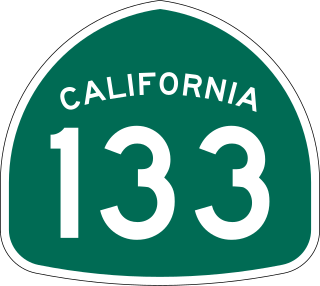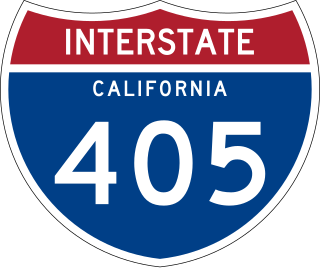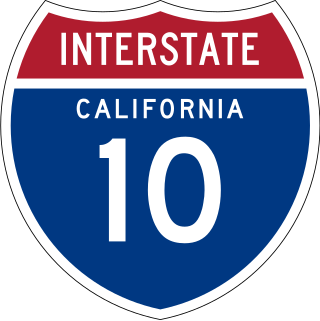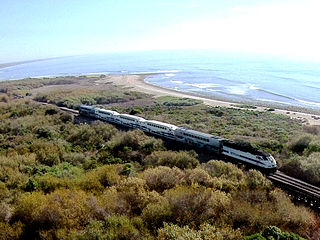
The Orange County Transportation Authority (OCTA) is the transportation planning commission for Orange County, California, in the Los Angeles metropolitan area. OCTA is responsible for funding and implementing transit and capital projects for the transportation system in the county, including freeway expansions, express lane management, bus and rail transit operation, and commuter rail funding and oversight.

The Los Angeles County Metropolitan Transportation Authority (LACMTA), branded as Metro, is the county agency that plans, operates, and coordinates funding for most of the public transportation system in Los Angeles County, California, the most populated county in the United States.

State Route 91 (SR 91) is a major east–west state highway in the U.S. state of California that serves several regions of the Greater Los Angeles urban area. A freeway throughout its entire length, it officially runs from Vermont Avenue in Gardena, just west of the junction with the Harbor Freeway, east to Riverside at the junction with the Pomona and Moreno Valley freeways.

State Route 133 (SR 133) is a state highway in the U.S. state of California, serving as an urban route in Orange County. It connects SR 1 in Laguna Beach through the San Joaquin Hills with several freeways in Irvine, ending at the SR 241, a toll road in the latter city. It is built as an expressway from SR 73 to Laguna Canyon Road, and past this, SR 133 is a freeway to I-5, and a tollway to SR 241 near the Santa Ana Mountains.

Interstate 405 is a major north–south auxiliary Interstate Highway in Southern California. The entire route is known as the northern segment of the San Diego Freeway. I-405 is a bypass auxiliary route of I-5, running along the southern and western parts of the Greater Los Angeles urban area from Irvine in the south to Sylmar in the north.

FasTrak is the electronic toll collection (ETC) system used in the state of California in the United States. The system is used statewide on all of the toll roads, toll bridges, and high-occupancy toll lanes along the California Freeway and Expressway System.

Metrolink is a commuter rail system in Southern California, serving Los Angeles, Orange, Riverside, San Bernardino, and Ventura counties, as well as to Oceanside in San Diego County. The system consists of eight lines and 69 stations operating on 545.6 miles (878.1 km) of track. This includes Arrow, which Metrolink operates under a contract with the San Bernardino County Transportation Authority (SBCTA).

The El Toro "Y" is a freeway interchange in Irvine, California where the Santa Ana Freeway, Interstate 5 (I-5), and the San Diego Freeway merge. South of the El Toro Y, the highway is named the "San Diego Freeway" with the highway designation "I-5." Located in south Orange County, the interchange was named after the nearby city El Toro, and the now-closed Marine Corps Air Station El Toro, located northeast of the interchange.

A vast network of interconnected freeways in the megaregion of Southern California serves a population of over 23 million people. The Master Plan of Metropolitan Los Angeles Freeways was adopted by the Regional Planning Commission in 1947 and construction began in the early 1950s. The plan hit opposition and funding limitations in the 1970s, and by 2004, only some 61% of the original planned network had been completed.

State Route 73 (SR 73) is an approximately 17.76-mile (28.58 km) state highway in Orange County, California. The southernmost 12 miles (19.31 km) of the highway is a toll road operated by the San Joaquin Hills Transportation Corridor Agency named the San Joaquin Hills Transportation Corridor, which opened in November 1996. The northernmost 5.76 miles (9.27 km) of the highway, which opened in 1978, is part of the Corona del Mar Freeway. SR 73's southern terminus is at Interstate 5 (I-5) near the San Juan Capistrano–Mission Viejo–Laguna Niguel tripoint. Its northern terminus is at Interstate 405 (I-405) in Costa Mesa. The highway's alignment through the San Joaquin Hills follows an approximately parallel path between the Pacific Coast Highway and I-405. Currently, there are no HOV lanes for the three-mile freeway segment, but the medians have been designed with sufficient clearance for their construction should the need arise in the future.

State Route 241 (SR 241) is one of the two state highways in California that are controlled-access toll roads for their entire lengths. SR 241's southern half from near Las Flores to near Irvine is the Foothill Transportation Corridor, while its northern half to SR 91 on the Anaheim–Yorba Linda border forms part of the Eastern Transportation Corridor system with SR 133 and SR 261.

State Route 261 (SR 261) is a state highway that forms part of the Eastern Transportation Corridor toll road system in Orange County, California that is operated by the Transportation Corridor Agencies. It runs from Walnut Avenue and Jamboree Road in Irvine north to SR 241. North of this interchange, SR 241 becomes part of the Eastern Transportation Corridor. SR 261 parallels Jamboree Road for its entire length. SR 261 does not directly connect with I-5 in Irvine, as Jamboree Road and other streets must be used to make the connection.

The Surf Line is a railroad line that runs from San Diego to Orange County along California's Pacific coast. It was so named because much of the line is near the Pacific Ocean, within less than 100 feet (30 m) in some places. It is the second busiest passenger rail corridor in the United States after the Northeast Corridor.

Interstate 10 (I-10) is a transcontinental Interstate Highway in the United States, stretching from Santa Monica, California, to Jacksonville, Florida. The segment of I-10 in California, also known as the Pearl Harbor Memorial Highway, runs east from Santa Monica through Los Angeles, San Bernardino, and Palm Springs before crossing into the state of Arizona. In the Greater Los Angeles area, it is known as the Santa Monica and San Bernardino freeways, linked by a short concurrency on I-5 at the East Los Angeles Interchange. I-10 also has parts designated as the Rosa Parks and Sonny Bono Memorial freeways. Some parts were also formerly designated as the Christopher Columbus Transcontinental Highway. However, the California State Legislature removed this designation following the passage of a bill on August 31, 2022. I-10 is also known colloquially as "the 10" to Southern California residents (See also California English § Freeways).

Trestles is a collection of surfing spots between northern San Onofre State Beach in San Diego County and southern San Clemente in Orange County in California. Trestles consists of, from north to south, Upper Trestles (Uppers), Lower Trestles (Lowers), and Middle Trestles (Middles). North of Upper Trestles is the surf spot called Cottons. South of Middles is the surf spot called The Church. Middles gets its name because it was a middle area between Trestles and The Church (sometimes just called "Church". It is named after Trestles Bridge, a wooden trestle bridge that surfers must walk under to reach the beach, replaced in 2012 by a concrete viaduct.

Route 15, consisting of the contiguous segments of State Route 15 (SR 15) and Interstate 15 (I-15), is a major north–south state highway and Interstate Highway in the U.S. state of California, connecting San Bernardino, Riverside, and San Diego Counties. The route consists of the southernmost 289.24 miles (465.49 km) of I-15, which extends north through Nevada, Arizona, Utah, Idaho, and Montana to the Canada–US border. It is a major thoroughfare for traffic between San Diego and the Inland Empire, as well as between Southern California, Las Vegas, Nevada, and the Intermountain West.

Jamboree Road is a 15.8-mile (25.4 km) long major arterial road through Orange County, California, running through the cities of Newport Beach, Irvine, Tustin, and Orange.
Panhe was one of the largest Acjachemen villages confirmed to be over 9,600 years old, and a current sacred, ceremonial, cultural, and burial site for the Acjachemen people. The site of Panhe is now within San Onofre State Beach, San Diego County, California, located at the mouth of San Mateo Canyon and Cristianitos Canyon, and approximately 3.7 miles (6.0 km) upstream from the Pacific Ocean. Mission's records have shown evidence of many Acjachemen's ancestry in Panhe.

The San Bernardino County Transportation Authority (SBCTA) is the successor to San Bernardino Associated Governments (SANBAG). They are responsible for administering the Measure I half-cent tax which voters in San Bernardino County, California, passed most recently in 2004. The SBCTA conducts transportation planning, construction, and operation in San Bernardino County. The SBCTA is a joint powers authority comprising the entire county and its cities. Every city and county supervisor is provided one seat on the board, and it also includes a nonvoting member from the California Department of Transportation's (Caltrans) District 8.

















